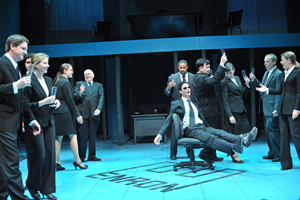As the sun set on the workday world of Greenville, North Carolina, the lights of one house rose on the Ensemble Vermillian, a group of five gifted musicians dedicated to the advancement of the Baroque repertoire and historically informed performance. The setting could not have been more perfect, an evening of chamber music played in its natural surroundings of a beautiful yet intimate space.
Those attending left the hubbub of daily routine the moment they walked through the doors of The Music House, a grand old Victorian painstakingly restored by owner John B. O’Brien, Professor of Music at East Carolina University. No detail has escaped attention — even ceilings boast ornate papers — and the event’s ambience called to mind Wagner’s Gesamtkunstwerk, a total work of art in which all details, visual and aural, were taken into consideration.
So the evening commenced with performers and audience sitting on ornate side chairs in a spacious room hung with gold draperies and art, and a sublime rendition of J.S. Bach’s Trio Sonata in F, S.529. Works that followed included sonatas by Heinrich Ignaz Franz von Biber, Dietrich Buxtehude, and Francesco Maria Veracini, and the Ballo del Gran Duca by Giovanni Battista Buonamente, the night’s shimmering capstone.
In keeping with a Baroque aesthetic, the musicians of Ensemble Vermillian played on instruments of various types: recorders and archlute, and Baroque violin, organ, and cello. These instruments differ from their modern counterparts in material, design, and playing technique, producing timbres that allow each to retain its unique character while blending with its partners. This concerted sound and the splendid Baroque repertoire are somewhat overshadowed by more recent instruments and music, so this event presented a rare opportunity to hear Baroque masterpieces performed on period instruments, and at an exceptional level of skill and insight.
An element that cannot be overlooked in Baroque music was the composer’s concern for the effect of music on the listener. Audience response was not a casual bi-product, as it may be today, but music was intentionally designed to alter and balance the listener’s emotions. This evening’s concertgoers could scarcely escape the salutary effects of the music. While some works may have been obscure, such as Lelio Colista’s Symphonia 6 in G Minor, the Passacaille by Andrea Falconieri, and Antonio Bertali’s Sonata à 3 in A Minor, all were performed with care and beauty, and the effect on the audience was almost palpable. One comment, “While I listened to this music all the stress of the day disappeared,” confirmed that this convincing and adventuresome performance was what the ensemble would have wished, and what perhaps all art should be, a balm for the human spirit in the midst of a busy world.
Ensemble Vermillian has released three CD’s, of seventeenth-century German and Italian music, and an upcoming project highlights English music of the same era. Group members possess extensive performance, recording, and academic résumés, and represent some of today’s finest Baroque music interpreters: Frances Blaker, recorders; David Wilson, baroque violin; Barbara Blaker Krumdieck, baroque cellist; Dan Smith, vocalist, lutenist, guitarist and gambist; and John B. O’Brien, keyboardist.











